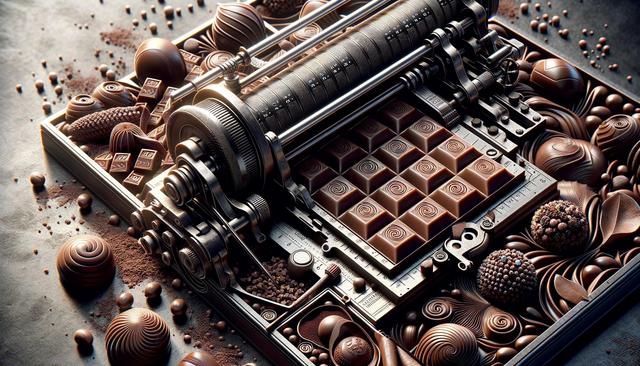The Importance of Chocolate Packaging Chocolate packaging serves a critical role in the confectionery industry, far beyond mere aesthetics.
Appropriate packaging can protect chocolate from external factors such as light, heat and moisture, maintaining its texture and flavor. More importantly, in the market competition, innovative packaging can enhance the competitiveness of products and influence purchasing decisions.

Preserving Quality Through Protection
The primary function of packaging for chocolates is to act as a barrier between the product and external elements. Chocolate is particularly sensitive to environmental conditions such as temperature, humidity, and direct sunlight. Exposure to these factors can result in texture changes, bloom formation, and loss of flavor. Effective packaging solutions, including Chocolate Packing Boxes and sealed wrappers, help maintain the integrity of the product throughout its shelf life. Materials used in packaging must be carefully selected to provide thermal insulation, moisture resistance, and light blocking properties. For example, foil-based wrappers often serve as a crucial layer to preserve the freshness of Chocolate Candy.
In addition to physical protection, packaging also plays a role in ensuring hygiene. Sealed packaging prevents contamination during transportation and handling. Modern technologies, such as a Chocolate Foil Packaging Machine, contribute to consistent sealing processes, reducing human contact and enhancing sanitary conditions. By maintaining optimal conditions from factory to consumer, packaging ensures that chocolate reaches the end customer in peak condition.
Enhancing Shelf Appeal and Brand Identity
Packaging isn’t just about protection—it also serves as a powerful marketing tool. In a competitive confectionery market, standing out on shelves is essential. Attractive and thoughtfully designed packaging can capture consumer attention and evoke positive emotions associated with indulgence and quality. Personalized Chocolate Packaging allows brands to tailor their messaging, colors, and visuals to specific demographics or occasions, such as holidays or events.
Some effective packaging elements that influence buying decisions include:
- Color schemes that suggest flavor or luxury
- Typography that reflects brand personality
- Clear labeling of ingredients and certifications
- Unique shapes and opening mechanisms
Packaging also contributes to brand storytelling. Whether it’s through sustainable materials or designs that reflect heritage, packaging helps convey a brand’s values and connect with consumers on an emotional level. As a result, it plays an integral role in building customer loyalty and repeat purchases.
Functional Considerations in Packaging Design
While aesthetics and protection are essential, functionality remains a core consideration in chocolate packaging. Ease of use—how simply a package opens and reseals—can significantly impact consumer experience. For example, individually wrapped pieces in a larger box offer convenience for portion control and sharing. Chocolate Packing Boxes can be designed with inserts to hold each piece securely, preventing damage during transit.
From the manufacturing perspective, compatibility with packaging machinery is crucial. The integration of automation, such as the use of a Chocolate Foil Packaging Machine, increases efficiency and consistency. Packaging materials must be chosen not only for their protective properties but also for their ability to run smoothly on production lines.
Additionally, businesses must consider logistics and storage. Stackable, lightweight packaging reduces transportation costs and minimizes the environmental footprint. In this context, the use of Plastic and Packaging Products is widespread, although many manufacturers are moving toward recyclable or biodegradable alternatives to meet sustainability goals.
Customization and Seasonal Variability
Customization adds a layer of value to chocolate packaging, especially in gift-giving contexts. Personalized Chocolate Packaging can include names, messages, or custom graphics suited for events such as weddings, birthdays, or corporate gifts. This not only enhances the perceived value of the product but also adds a personal touch that resonates with recipients.
Seasonal variations also demand flexible packaging strategies. Festive packaging during holidays like Valentine’s Day or Christmas often features themed colors, symbols, and limited-edition designs. These adaptations can drive short-term sales spikes and create a sense of urgency among consumers. Manufacturers often prepare multiple versions of Packaging for Chocolates to accommodate these seasonal demands, ensuring relevance throughout the year.
Moreover, personalized and seasonal packaging can be an effective tool for small businesses and boutique chocolatiers who wish to differentiate their offerings. By leveraging creative packaging designs, they can compete with larger brands and attract niche markets interested in unique or artisanal products.
Sustainability and the Future of Chocolate Packaging
As environmental concerns grow, the future of chocolate packaging is increasingly shaped by sustainability. Consumers are becoming more conscious about the impact of their purchases, prompting brands to explore eco-friendly alternatives. While Plastic and Packaging Products have dominated the industry for decades due to their affordability and durability, there is a clear shift toward recyclable, compostable, and minimalistic packaging solutions.
Current trends in sustainable packaging include:
- Biodegradable wrappers made from plant-based materials
- Recyclable cardboard boxes with soy-based inks
- Reduced packaging to minimize waste
- Refillable or reusable containers
Adopting these innovations not only reflects a company’s commitment to the environment but also appeals to a growing segment of eco-conscious consumers. In this evolving landscape, companies that prioritize sustainability in their Packaging for Chocolates are likely to gain a competitive edge while contributing to broader environmental goals.
Conclusion: Packaging as a Strategic Asset
In the confectionery industry, chocolate packaging is far more than a protective shell—it is a strategic tool that influences product quality, consumer perception, and brand success. From Chocolate Packing Boxes that preserve delicate truffles to Personalized Chocolate Packaging that enhances gift appeal, the choices made in packaging design and materials have a direct impact on market competitiveness. As technology advances and sustainability becomes more critical, investing in innovative, functional, and responsible packaging solutions will remain essential. For businesses aiming to stand out in a crowded market, thoughtful packaging is a key component of long-term success.